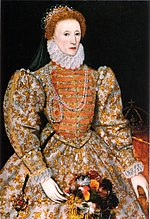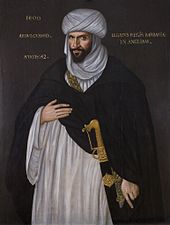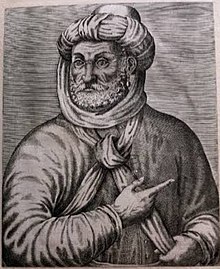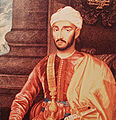English-Moroccan Alliance

|

|
|
|
Left picture : Queen Elizabeth I of England
Right picture : Abd el-Ouahed ben Messaoud , Moroccan envoy to Queen Elizabeth, 1600 |
||
The Anglo-Moroccan Alliance existed between the English monarchy and the Saadi dynasty of Morocco from the late 16th to the early 17th centuries . Trade agreements were made between Queen Elizabeth I of England and the Moroccan ruler Ahmad al-Mansur on the basis of their mutual hostility to King Philip II of Spain . The arms trade predominated in the exchange of goods, but there was also repeated direct military cooperation. The successors of the two rulers maintained the alliance for a while.
background
In the 16th century, through the mediation of the Amphlett family, there was a regular trade in goods between the two states. European trade with Morocco was largely dominated by Spain, Portugal and Genoa , but with the loss of the Moroccan cities of Safi and Agadir in 1541, Portugal's influence waned.
After the Lion's journey under Thomas Wyndham in 1551 and the founding of the English Barbary Company in 1585, trade flourished between England and the barbarian states , especially with the Saadite dynasty of Morocco. Sugar , ostrich feathers and saltpetre from Morocco were exchanged for English cloth and firearms , often under protest from Spain and Portugal.
Elizabeth I and Sultan Abu Marwan Abd al-Malik were in frequent contact to promote trade and to obtain privileges for English merchants. The sultan spoke both Spanish and Italian. In 1577 he wrote in Spanish in Latin script to the Queen of England, and signed with AbdelMeleck . In the same year the Queen sent Edmund Hogan as ambassador to the Moroccan court.
alliance


Initially, Elisabeth hesitated to promote the arms trade with Morocco, worried about resistance from other European countries, and had Hogan inform the Sultan of this in 1577. In 1586 Elizabeth I had a legal opinion drawn up to justify her alliance policy. There it says: "If your Majesty use the King of Fez, you will not arm a barbarian against a Christian, but a pagan against a heretic." The contacts developed in the course of the further diplomatic exchange between Elisabeth and Sultan Ahmad al-Mansur closer, especially after Portugal's defeat in the battle of Alcácer-Quibir in 1578.
Anglo-Spanish War
Relations between England and Morocco became closer after Philip II of Spain had himself proclaimed King of Portugal in 1580, and in the wake of the Anglo-Spanish War that broke out in 1585 . In 1581 Elisabeth allowed the export of wood suitable for shipbuilding to Morocco in exchange for saltpetre, which was used for the manufacture of gunpowder . The founding of the Barbary Company in 1585 should give England a trading monopoly for 12 years. 1585–1588 Elisabeth tried through her envoy Henry Roberts to win the support of the Sultan in order to enforce António von Cratos claims to the Portuguese throne against Philip II of Spain. In 1588, Al-Mansur granted English merchants special privileges.
In her letters to Al-Mansur, Elisabeth repeatedly described the relationship between the two countries for 25 years as "La buena amistad y confederación que hay entre nuestras coronas" ("The good friendship and the alliance between our crowns") and herself as "Vuestra hermana y pariente según ley de corona y ceptro" ("Your sister and relatives according to the law of the crown and scepter").
In January 1589 Al-Mansur asked through his ambassador Marsuq Rais (Mushac Reyz) for rowers, carpenters and shipbuilders as well as for troop transports on English ships, in exchange for 150,000 ducats and military support for an Anglo-Moroccan campaign against Spain in favor of the Portuguese aspirant to the throne . He also asked for military support from England in the event of a conflict with non-Christian neighboring countries. Elisabeth found herself unable to meet all demands, so that the negotiations dragged on until the death of António von Cratos in 1595. The English Armada against Portugal nevertheless set sail in 1589, but did not achieve its goals and suffered heavy losses. Only the Moroccan ambassador Marzuq Rais accompanied the Armada on board the flagship Dom Antónios, disguised as a Portuguese nobleman, and stayed until the summer of 1589.
Legation from 1600
Diplomatic relations between England and the barbarian states grew closer and closer over time. England expanded its trade relations with Morocco to the detriment of Spain, despite a papal ban, so that the papal nuncio in Spain felt compelled to report on Elizabeth: “This woman leaves no evil out; apparently they even supplied Mulocco ( Abd-el-Malek ) with weapons and even artillery ”.
In 1600, Abd el-Ouahed ben Messaoud , the secretary of Ahmad al-Mansur, traveled to the court of Elizabeth I as ambassador. Ben Messaoud stayed there for six months to negotiate an alliance against Spain. The Sultan wanted the support of the English fleet for a planned invasion of Spain. Elisabeth refused, but welcomed the embassy as a token of encouragement and instead consented to further trade agreements. Elisabeth and al-Mansur discussed further plans for joint military operations, with Elisabeth demanding an advance payment of 100,000 ducats for the provision of a fleet, and al-Mansur in return demanding a large ship to be able to send the money. The negotiations ultimately remained unsuccessful, and both rulers died a few years after this delegation.
James I. and Charles I.
After the death of al-Mansur in 1603, anarchy prevailed in Morocco and local rulers fought for supremacy. Under these conditions, the alliance became less important. In 1604 James I of England made the peace of London with Spain. Diplomatic relations continued under James I. In 1610, 1613 and 1615 John Harrisson was sent to the court of Saidan al-Nasir to negotiate the release of English prisoners in Morocco. English privateers such as John Warde (Yusuf Raïs) carried out their pirate trips from the barbarian states.
During the reign of Charles I , England asked for military support in Morocco against Spain in Tetouan and Salé, as well as in the Cádiz campaign in 1625, which ended with a heavy defeat for England at sea. On May 10, 1627, England concluded an agreement with Sidi Al-Ayyashi , originally governor (qā′id) of the Sultan in Azemmour , who had proclaimed himself an independent ruler in 1627. English prisoners were to be released in exchange for provisions and weapons. The alliance between England and Al-Ayyashi lasted for about 10 years; together they tried to conquer Al Ma'mura for Al-Ayyashi. In 1632 the city of Salé, a major pirate port, was occupied by combined English and Moroccan troops, and Christian prisoners were freed. On May 13, 1637, Charles I and al-Ayyashi signed a treaty that provided arms for the ruler.
Mulai Ismail's embassies
Relations continued under Sultan Mulai Ismail . In 1682 he sent Mohammed bin Hadou as ambassador to the English court. Bin Hadou stayed in England for six months. He visited Oxford , Cambridge and the Royal Society , among others . His visit ushered in a period of alternating close alliances between England and Morocco, which were shaped by the European conflicts, trade issues, the piracy of the barbarian states and the exchange of prisoners. Relations reached a climax in 1720-21 when the English ambassadors John Windus and Commodore Charles Stewart visited Morocco. They managed to sign a treaty with Morocco. They returned with 296 English slaves freed . 1726 again Moroccan ambassadors were sent to England ("Mahomet" and "Bo-ally"), in 1727 John Russel again signed a contract with Ismail's successor.
James I of England depicted on an oriental carpet , by Paul van Somer I.
Mohammed bin Hadou , Moroccan Ambassador to England, 1682.
Ambassador Admiral Abdelkader Perez , 1723–1737.
Influence on literature
It is believed that the close ties between England and Morocco influenced the English literature of the period, for example as the subject of the play The Battle of Alcazar by George Peele . In the works of Shakespeare , the characters of Shylock or the Prince of Morocco in The Merchant of Venice are traced back to knowledge of Morocco. Individual authors argue that the title character of Othello could be inspired by Abd el-Ouahed ben Messaouds.
See also
literature
- Khalid Ben Srhir, Malcolm Williams, Gavin Waterson: Britain and Morocco during the embassy of John Drummond Hay, 1845-1886 . Routledge Curzon, 2005, ISBN 0-7146-5432-9 .
- Jamil M. Abun-Nasr: A history of the Maghrib in the Islamic period . Cambridge University Press, Cambridge, UK 1987, ISBN 0-521-33767-4 .
Individual evidence
- ↑ a b c d e f g h Khalid Ben Srhir, Malcolm Williams, Gavin Waterson: Britain and Morocco during the embassy of John Drummond Hay, 1845-1886 . Rotledge Curzon, 2005, ISBN 0-7146-5432-9 , pp. 13 ( limited preview in Google Book search).
- ↑ a b c d e Kenneth R. Andrews: Ships, money, and politics: Seafaring and Naval Enterprise in the Reign of Charles I . Cambridge University Press, Cambridge, UK 1991, ISBN 0-521-40116-X , pp. 167 ( limited preview in Google Book search).
- ^ Jamil M. Abun-Nasr: A history of the Maghrib in the Islamic period . Cambridge University Press, Cambridge, UK 1987, ISBN 0-521-33767-4 , pp. 219 ( limited preview in Google Book search).
- ^ Andrew N. Porter: Atlas of British overseas expansion . Routledge, 1997, ISBN 0-415-06347-7 , pp. 18 ( limited preview in Google Book search).
- ^ George Cawston, Augustus Henry Keane: The Early Chartered Companies (AD 1296-1858) . The Lawbook Exchange, Union, NJ 2002, ISBN 1-58477-196-8 , pp. 236 ( limited preview in Google Book search).
- ^ A b c d e Virginia Mason Vaughan: Performing Blackness on English Stages, 1500-1800 . Cambridge University Press, Cambridge, UK 2005, pp. 57 ( limited preview in Google Book search).
- ^ Nabil Matar: Europe Through Arab Eyes, 1578-1727 . University Press Group, 2008, ISBN 978-0-231-14194-9 , pp. 75 ( limited preview in Google Book search).
- ↑ a b c d e f Jamil M. Abun-Nasr: A history of the Maghrib in the Islamic period . Cambridge University Press, Cambridge, UK 1987, ISBN 0-521-33767-4 , pp. 218 ( limited preview in Google Book search).
- ^ A b c Allardyce Nicoll: Shakespeare Survey. The Last Plays . Cambridge University Press, Cambridge, UK 2002, ISBN 0-521-52347-8 , pp. 90 ( limited preview in Google Book search).
- ↑ John Leeds Barroll (Ed.): Shakespeare Studies, Vol. 31 . Fairleigh Dickinson Univ Press, Madison, NJ 2003, ISBN 0-8386-3999-2 , pp. 89 ( limited preview in Google Book search).
- ↑ Shakespeare and Renaissance Europe by Andrew Hadfield, Paul Hammond, p.225 [1]
- ↑ a b John Leeds Barroll (ed.): Shakespeare Studies, Vol 31st . Fairleigh Dickinson Univ Press, Madison, NJ 2003, ISBN 0-8386-3999-2 , pp. 102 ( limited preview in Google Book search).
- ↑ Details of the letters in Charles Edelman (Ed.): The Stukeley Plays . Manchester University Press, Manchester, UK, New York 2005, ISBN 0-7190-6234-9 , pp. 32–33 ( limited preview in Google Book search).
- ^ David S. Katz: The Jews in the history of England, 1485-1850 . Clarendon Press, Oxford, UK 1996, ISBN 0-19-820667-4 , pp. 71 ( limited preview in Google Book search).
- ^ Emily C. Bartels: Speaking of the Moor. From Alcazar to Othello . University of Pennsylvania Press, Philadelphia 2008, ISBN 978-0-8122-4076-4 , pp. 24 ( limited preview in Google Book search).
- ^ Matthew Dimmock: New Turkes: Dramatizing Islam and the Ottomans in Early Modern England . Ashgate, Farnham, UK 2005, ISBN 0-7546-5022-7 , pp. 122, footnote 63 ( limited preview in Google Book search).
- ^ University of Birmingham Collections [2] , accessed June 7, 2016
- ^ Tate Gallery , exhibition "East-West: Objects between cultures" online , accessed June 7, 12016
- ↑ Karen Ordahl Kupperman: The Jamestown project . Harvard University Press, Cambridge, MA; London, UK 2007, ISBN 978-0-674-02474-8 , pp. 39 ( limited preview in Google Book search).
- ^ Allardyce Nicoll: Shakespeare Survey. The Last Plays . Cambridge University Press, Cambridge, UK 2002, ISBN 0-521-52347-8 , pp. 96 ( limited preview in Google Book search).
- ^ PM Holt, Ann KS Lambton, Bernard Lewis (eds.): The Cambridge history of Islam . Cambridge University Press, Cambridge, UK 1970, ISBN 0-521-29137-2 , pp. 247 ( limited preview in Google Book search).
- ↑ a b c d Khalid Ben Srhir, Malcolm Williams, Gavin Waterson: Britain and Morocco during the embassy of John Drummond Hay, 1845-1886 . Drummond, 2005, pp. 14 ( limited preview in Google Book search).
- ↑ George Henry Townsend: A manual of dates . Frederick Warne & Co., London 1867, p. 869 ( limited preview in Google Book search).
- ^ Adam Anderson, William Combe: An Historical and Chronological Deduction of the Origin of Commerce . London 1801, p. 1631 ( limited preview in Google Book search).
- ^ A b Richard Nash: Wild enlightenment: The borders of human identity in the eighteenth century . Univ. of Virginia Press, Charlottesville, VA 2003, ISBN 0-8139-2165-1 , pp. 54 ( limited preview in Google Book search).
- ↑ a b Gustav Ungerer: Portia and the Prince of Morocco. In: John Leeds Barroll (Ed.): Shakespeare Studies, Vol. 31 . Fairleigh Dickinson Univ Press, Madison, NJ 2003, ISBN 0-8386-3999-2 , pp. 103 ( limited preview in Google Book search).



